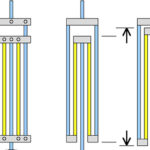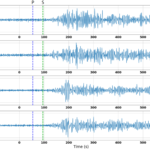As the recent loss of OceanGate’s Titan tourist vessel has revealed, exploring in the ocean’s depths is very risky business. To see the Titanic up close and personal, the Titan would have to travel to a depth of 3,800 m (12,467 ft), where the pressure is 382.45 bar (5,547.14 psi or 38,246.06 kPa).
It turns out that the average ocean depth is 3,682 meters (12,080 feet) as calculated in 2010 by scientists from National Oceanic and Atmospheric Administration (NOAA) and Woods Hole Oceanographic Institution using satellite measurements. The Titanic is located slightly deeper than the average depth and nowhere near the deepest place in the world’s oceans. That is in the South Pacific’s Mariana Trench. It is more than 35,000 feet (10,668 m) deep resulting in a pressure of 15,456.11 psi.
To calculate the pressure at any depth in a fluid, the hydrostatic pressure equation is:
P = ρgh
Where:
ρ is the density of the liquid and for sea water this is 1026 kg/m3
g is the gravitational acceleration which equals 9.81 m/s and
h is the depth inside the liquid body
At an ocean depth of 3,800 meters,
P = ρgh = 1026 kg/m3 * 9.81 m/s * 3800 = 3,8247,228 kg/m2
Note: 1 Pa = 0.10kg/m2
However, the most common and expedient measurement of ocean depth uses sound. A sound navigation and ranging (sonar) sensor can map the topography of the ocean floor. It works by sending sound waves to the bottom of the ocean and measuring how long it takes for an echo to return.
Another “echo” measurement technique involves radar. A radar altimeter measures the distance from land to air by timing how long it takes for radio waves to reflect from the surface back to a satellite. While the sensor looks at the sea surface, it actually detects changes over features like a mountain on the seafloor providing a depth measurement.
Measuring the pressure from the overlying ocean at a specific site at the bottom of the ocean can be accomplished by a Bottom Pressure Recorder (BPR). If the seafloor moves up or down, the sensing instrument measures less or more pressure. Usually deployed for a year or two at a time, a BPR will typically make a measurement every 15 seconds.
To measure pressures on a remotely operated vehicle (ROV), deep sea test equipment, or an undersea vehicle like the Titan, a pressure sensor must be able to handle submersion to as much as 6,000 meters depth in sea water. The PR3930 subsea pressure transducer from Suco Esi has been designed to meet these demanding requirements. The sensor uses silicon-on-sapphire technology to provide excellent stability over a wide temperature range. The design consists of a piezoresistive silicon strain gauge epitaxially grown onto the surface of a sapphire diaphragm to form a single crystalline structure. Then, the sensor element is molecularly bonded to a titanium alloy sub-diaphragm. This construction enables the sensor to withstand higher over-pressures and have superb corrosion resistance.
Intended for permanent immersion in sub-sea environments, the sensor is housed in a fully welded body and can withstand external pressures in ocean depths of up to 6,000 meters. To verify the sensor’s integrity, units can be supplied with hyperbaric test certificates to 3,000 meters water submersion.
The bottom (of the ocean) line While the outside of the submersible’s hull anywhere near the Titanic would have been over 5,000 psi, the inside would have been at atmospheric pressure or 14.7 psia. A hull failure causing a collapse would result in inward movement at about 1,500 mph (2,414 km/h) or 2,200 ft (671 m) per second according to one expert and it would be over within 1 millisecond. There would not be time to warn occupants or respond.
References https://www.social-diving.com/water-pressure-calculator/
Hydrostatic Pressure Calculator
How Do You Measure the Depth of the Ocean?
Seafloor Instruments for monitoring submarine volcanoes
Subsea Pressure Transmitter with RS-485 Interface, PR3930
Titan sub implosion: What we know about catastrophic event




